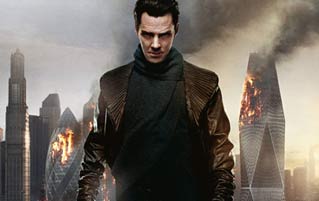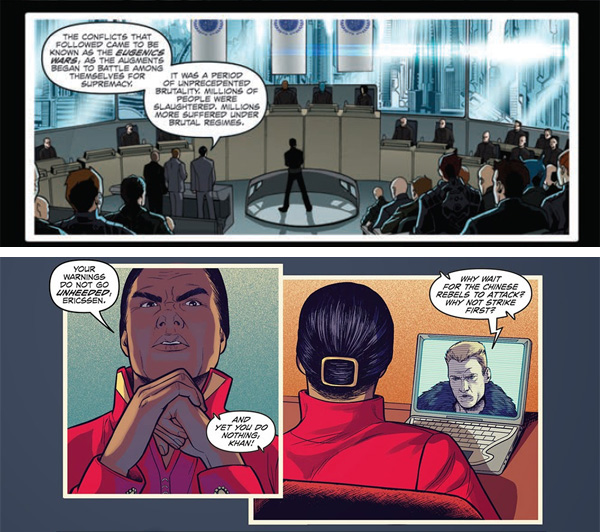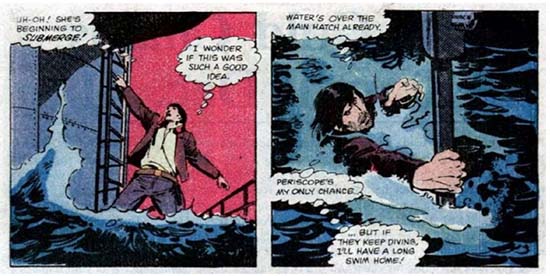6 Ridiculous Ways Movies Plugged Up Famous Plot Holes

We get it -- making movies and TV is an exhausting job, moreso if the production involves Edward Norton. Filmmakers don't always have the time or mental energy to make sure everything makes total sense. This results in the sort of logical cock-ups and plot holes that certain people love to mock them for.
A lot of the time, however, those apparent mistakes do have logical explanations ... just not in the movies and shows themselves. To get the missing parts of the plot, you need to brace yourself and dig into far more obscure (read: nerdier) sources, like ...
There's A Reason Khan Was Suddenly A White Dude In Star Trek Into Darkness

Star Trek Into Darkness, the 9/11 Truther-est entry in the beloved franchise, sure raised a lot of odd questions. Did Bones cure death? Does nobody give a shit about Prime Directive? Why does the Captain Kirk of this timeline have a thick head of natural hair instead his familiar Tribble-like toupee? However, the movie's most glaring misstep was the casting of Khan, the villainous Indian Sikh who was originally played by Mexican actor Ricardo Montalban ... which probably wasn't cool to begin with, considering they'd already invented Indian people in 1967. But even more not-cool, in Into Darkness, the role was played by a guy whose name is only slightly less British than "Monocle McTeapot III."

Yup, despite the fact that his only possible connection to India would be some kind of colonial history in his family, the extremely white Cumberbatch played Khan. Naturally, a lot of people called the movie out for casting a white actor who also never once attempted to proudly display his glistening man-cleavage.
But rather than leave this kinda racist thread hanging in the middle of Star Trek's continuity, the comic book tie-in stepped up to the plate and addressed the pasty white elephant in the room. The series Star Trek: Khan takes place immediately after the events of Into Darkness, with Khan on trial for all of his evil dickishness. We then see flashbacks to Khan's past, when he looks like a combination of Montalban and, you know, an actual Indian person.

This even causes some confusion at the trial:

"... the fuck, dude?"
It's eventually revealed that the evil Admiral Marcus surgically altered Khan -- either so Khan wouldn't be recognized from his role in history, or because he was simply a huge Sherlock fan.

But hey, at least the comic tried to make some sense of all this, and did so without some kind of half-baked explanation of how the new movies series' alternate timeline split rippled backwards through the spacetime continuum, changing Khan's race. Because as we all know that would only alter his sexual orientation.
Lost Wrapped Up All The Mysteries The Show Forgot (On The DVD)

The beloved TV series Lost sure generated a lot of intriguing questions. Like, why is there a freaking polar bear in a tropical island? Who's sending shipments of food to the castaways? What's with that freaky torture room in season three? Waaaaaaaaalt?

While these mysteries were tantalizing, a lot of them were never answered by the time of the show's contentious finale -- which, fair enough, needed to save screen time for ethereal Touched By An Angel-esque glowing lights. But what about all of those unanswered questions? Well, luckily for obsessive-compulsives (but unluckily for anyone hoping the answers to those questions would be organically addressed in the narrative in which they were initially raised), a DVD feature tried to fix everything.
Essentially a 10-minute episode, "The New Man In Charge" acts as an epilogue to the show, tying up loose ends and presumably acting as a sort of tourniquet to the angry fan letters everyone involved with the show were expecting. The story finds the creepy-eyed Ben Linus popping by an old Dharma Initiative warehouse, where two hapless dudes are still sending shipments of food to the Island, thus clearing that mystery up. It was two dumbasses. Happy, internet?!

In fact, assume "It was two dumbasses" is the answer to most mysteries in life.
When Ben shows up, these two unsubtle stand-ins for the show's fans demand answers, which they feel they're owed ... at which point Ben literally whips out a binder full of DVDs.

The DVDs clear up things like why there are polar bears on the island -- Dharma was doing experiments on them because of their prodigious memory, which is great news if you missed the five times the show itself answered that question. As for that crazy hypnosis room, it was a crazy room where they hypnotized people. Of course!

After spoon-feeding the two dum-dums with passive-aggressive answers to mysteries everyone thought would be relevant to the show itself, Ben then visits Walt -- you know, the kid from the early seasons who was blessed with magic powers, but cursed with the decidedly un-magic powers of puberty, which caused him to be written off the show.

It turns out he's been institutionalized, but Ben and Hurley bring him back to the Island. Which is a nice way of trying to rectify a major dropped thread, but it's kind of shitty that it was on a medium usually reserved for deleted scenes and expletive-filled bloopers.
A Comic Explains How Indiana Jones Survived Riding A Submarine

Indiana Jones has had a lot of wild adventures outside of the movies, from his escapades as a senile old coot to the time he fought vampires alongside a gun-toting child.

Well, before all that, one of the first bits of Indiana Jones merchandise to hit the streets was Marvel's comic book adaptation of Raiders Of The Lost Ark, which clears up one of the movie's big continuity problems, and also gives you an idea of what the movie would look like if Indy were played by a filthy drifter who wandered on the set by accident.

We've talked before about the baffling moment wherein Indy somehow survives riding on top of a submarine. Outside of one of David Blaine's mumbly self-mutilating stunts, why the hell would anyone do that? Also, more importantly, how?

"This is your other franchise, George."
It's been rumored that the logic behind Indy's lack of horrible drowning was explained in a scene that was deleted, presumably because the filmmakers figured that if you were already on board with Nazis harnessing magic Bible superpowers, you'd probably buy anything at that point. The comic book, on the other hand, devoted an entire goddamned page to explaining this nonsensical moment. First we see Indy realizing that his plan is super-shitty, and facing the realization that this may be the end of his ass-kicking, coed-philandering life.

Luckily, Indy realizes he can tie himself to the periscope with his whip, because fuck it, why not.

Indy miraculously survives the agonizing ordeal of being cut "to ribbons" by his whip and navigating in shark-infested waters without being eaten. He even manages to take a nap!

By the last panel, the experience has been so harrowing that it's seemingly turned Indy into Noel Gallagher -- which, come to think of it, is probably way worse than anything the Ark of the Covenant ever dished out.
The T2 Novelization Desperately Tried To Make Time Travel Make Sense

Let's face it: At this point, if the Terminator franchise's continuity was a person, you'd have them put in a home with no sharp objects in their room. The series is basically a free-for-all of time-travel-filled inanity, to the point where the newest installment in the series even seems to imply that a Terminator traveled back in time and changed how human beings spell the world "genesis."

But before the myriad of sequels, TV shows, and commercials for Toyota trucks that will almost certainly become sentient and kill you, there were only two movies. And even then, the logic didn't quite add up. How did the time travel in Terminator 2 work, exactly? When did Skynet send another Terminator, and why wait until John Connor is a pimply, Japanese-pop-charting preteen?
While the movie pretty much glosses over these questions, the dude writing the Terminator 2 novelization couldn't seem to let them drop. In fact, he spends a good 30 pages in the post-Judgment-Day future, trying to sort this shit out. We see John Connor send Kyle Reese into the past, then admit that he knew he was his dad the whole time.

And when did Skynet send the second movie's T-1000 back? Well, at the exact same time as the first movie's T-800, as insurance. This leads John to get a Terminator to reprogram:


"No way, there are only like five billion here."
It's a whole lot of effort to make sense of something that will probably never make sense. Hell, why wouldn't Skynet send a Terminator to off one of John Connor's ancestors in the days before shotguns and steel mills existed? Fortunately, rather than devote his life to untangling the madness of the mechanics of this killer robot movie, the author moved on to more interesting things, like implying you gotta move to Brazil to survive the robot uprising.

Before its recent resurrection, The X-Files had a series finale. Not an entirely satisfactory one, but a finale nonetheless. With the fad of TV shows coming back from the dead like nostalgia-powered Frankenstein monsters, the show's storyline continued in an official comic book series. The problem? In its final seasons, the show had committed to the television equivalent of drunkenly dousing your office in gasoline on your way out the door, killing off most of its beloved characters. So the comics had to figure out outlandish ways to fix that.
Here's the thing, though: The recent TV revival had to do the same thing, but in dumber and dumber ways. Take, for example, the Cigarette-Smoking Man. In the end of the original show, he gets blown up, and we specifically see his face melting off to the point where we can see his skull.

In the new TV show, they brought him back by ... making him look slightly deformed. Dude should be in a goddamn urn.

"This? No, this isn't from the explosion; it's from my nasty coke habit."
In the comics, they have to resort to crazy lengths to bring back the show's central villain -- but it's still way less ridiculous. He's a clone, who at the very least doesn't look like he's understudying for Skeletor.

Similarly, the show stupidly killed off the Lone Gunmen in the episode "Jump The Shark," an obvious reference to the Happy Days episode in which Fonzie was mauled to death. The revival, of course, brought them back -- but only in Mulder's dumb hallucination, and dressed like cowboys for some reason.

And they're wearing assless chaps, and Mulder is sporting a huge boner.
The comic series, on the other hand, painstakingly rewrote the show's history to reveal that they faked their deaths so they could "continue their operations more discreetly," and are now living beneath Arlington Cemetery. Far-fetched, sure, but completely in character for those lovable nerds.

Double agent Alex Krycek, too, is alive in the comics. It turns out he was abducted by aliens at one point in the show, and the guy we saw die was a, you know, whatever. The comics even managed to fit in topics that were deemed too controversial during the series' run, such as a storyline concerning an abortion clinic bombing. Yup, the medium that's home to Betty And Veronica is more daring and sophisticated than network television. Of course, the TV show has now usurped the comcis' continuity. And with rumors of yet another season on the horizon, we can all look forward to these characters being killed off yet again and improbably resurrected, in an endless, Groundhog Day-like cycle of torment.
Diarrhea Doomed The Death Star

Anyone who's ever picked up a Star Wars novel, played a Star Wars video game, or wiped their poop-hole with Star Wars toilet paper probably knows that the beloved franchise has a crazy huge extended universe.

There's almost no element of the movies that the Star Wars Expanded Universe didn't devote an entire story to, from all the weirdos at Jabba's Palace to the raging awkwardness of Luke and Leia's twin-cestuous flirtation. So it's not surprising that a lot of the writers hired to add on to the George Lucas' saga also saw it fit to try to fix some of the things that didn't totally add up.
Take, for example, the Death Star's fatal weakness: that thermal exhaust port. Isn't it kind of insane that nobody noticed that one torpedo to this small hole would cause the whole station to explode like some kind of Samsung product?


Sorry Samsung, but these jokes are here to stay.
Well, the aptly titled novel Death Star goes into detail about the construction of the station, and guess what? Someone totally did notice the problem. Unfortunately, the Wookiee slave worker who stumbled upon the Achilles Heel got sick and couldn't report it because he had to be quarantined with roaring diarrhea. That is not a joke:

Then there's the issue of Han Solo bragging that the Millennium Falcon made the Kessel Run in less than 12 parsecs -- a unit of distance, not time. This could have been nothing but Han's ignorant bullshitting, or more plausibly, Google didn't exist yet and George Lucas didn't know what the hell a Parsec was.

"Also, I won the Farcrombleng race in whatever the hell a Belarus is."
Either way, the Star Wars novel Rebel Dawn really tried to make sense out of the line, flashing back and showing that Han shortened the distance of the Kessel Run thanks to an adjacent black hole. That's right: The author used astrophysics to make sense of a space wizards movie.
And one of the biggest continuity problems created by the prequels was Leia's line about remembering her mother ...

"She looked a lot like, well ... huh."
... which makes no sense, because her mom clearly died moments after Luke and Leia were delivered by the gynecological equivalent of WALL-E.

The new Marvel comics try to bridge that logical gap showing that Leia had been having Force-inspired visions of her mom:

Either that, or they're implying that Leia was secretly getting goofy on bath salts the whole time. Tough to say!
2016 is almost over. Yes the endless, rotten shit hurricane of a year which took away Bowie, Prince and Florence Henderson and gave us Trump, Harambe and the Zika virus is finally drawing to a close. So, to give this bitch a proper viking funeral, Jack O'Brien and the crew, which includes Dan O'Brien, Alex Schmidt, and comedian Caitlin Gill, are going to send out 2016 with Cracked's year in review in review. They'll rectify where every other year-in-review goes wrong by giving some much needed airtime to the positive stories from the 2016 and shedding light on the year's most important stories that got overlooked. Get your tickets here.
For more plot explanations that were inexplicably left out of movies, check out 7 Famous Movie Flaws That Were Explained in Deleted Scenes and 6 Deleted Scenes That Totally Change Classic Movies.
Subscribe to our YouTube channel, and check out 7 Deleted Scenes That Were Necessary To The Plot, and other videos you won't see on the site!
Follow us on Facebook, and let's be best friends forever.